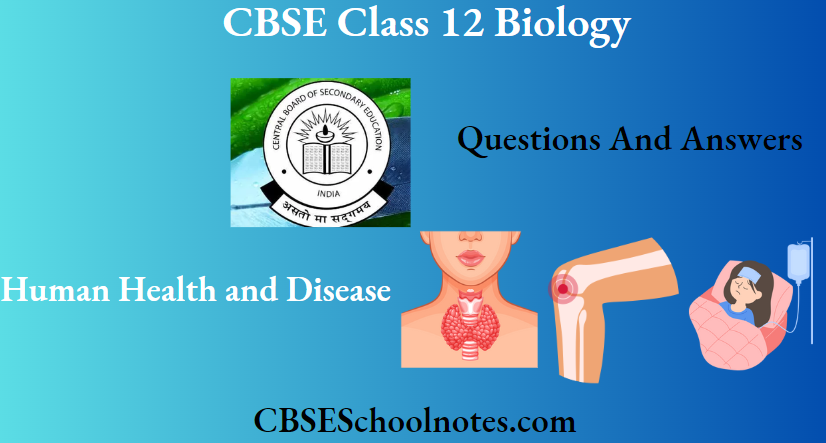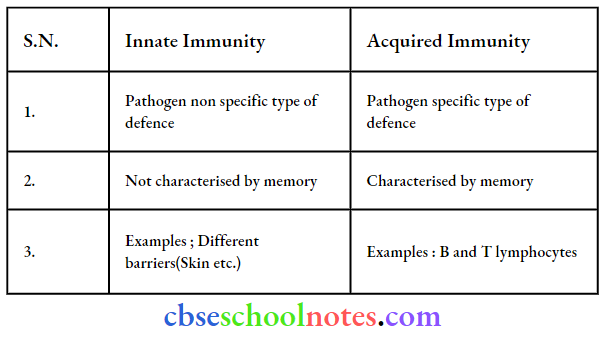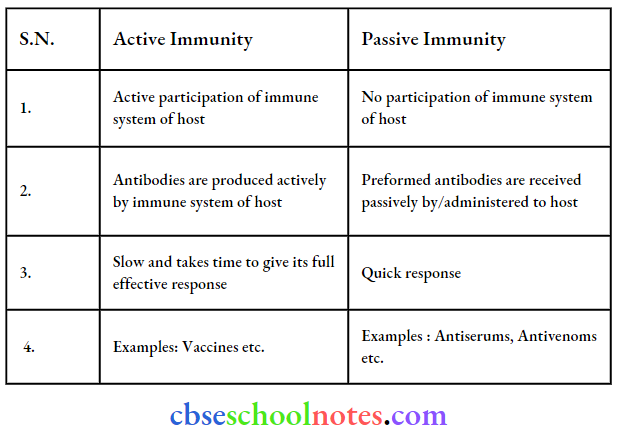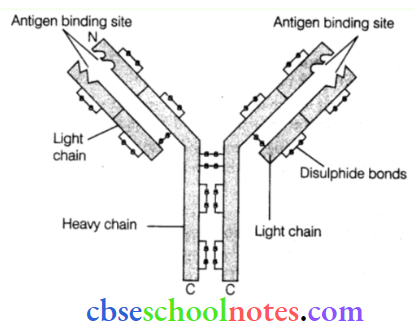Human Health And Disease Question And Answers
Question 1. What are the various public health measures, which you would suggest as safeguards against infectious diseases?
Answer:
A few of the public health measures as a safeguard against infectious diseases are :
- Proper disposal of waste and excreta
- Periodic cleaning and disinfection of water reservoirs, pools, cesspools, and tanks
- Observing standard practices of hygiene in public catering
Question 2. In which way has the study of biology helped us to control infectious diseases?
Answer:
The advancements made in biological science have armed us to effectively deal with many infectious diseases.
- The use of vaccines and immunization programs has enabled us to completely eradicate a deadly disease like smallpox and to control other infectious diseases like polio, diphtheria, pneumonia, and tetanus to a large extent.
- Biotechnology is on the verge of making available newer and safer vaccines.
- The discovery of antibiotics and various other drugs has also enabled us to effectively treat infectious diseases.
Question 3. How does the transmission of each of the following diseases take place?
- Amoebiasis
- Malaria
- Ascariasis
- Pneumonia
Answer:
- Amoebiasis:- Houseflies act as mechanical carriers and serve to transmit the pathogen (Entamoeba histolytica) from the feces of infected persons to food and food products, thereby contaminating them. Drinking water and food contaminated by fecal matter are the main sources of infection.
- Malaria:- Malaria is transmitted to a healthy person with the bite of an infected female Anopheles mosquito. The female mosquito is the vector (transmitting agent) for
the pathogen (Plasmodium). - Ascariasis:- The eggs of the pathogen are excreted along with the feces of infected persons which contaminate soil, water, plants, etc. A healthy person acquires this
- Pneumonia:- A healthy person acquires the infection by inhaling the droplets/aerosol released by an infected person or even by sharing glasses and utensils with an infected person.

Read and Learn More Class 12 Biology Chapter Wise
Question 4. What measures would you take to prevent water-borne diseases?
Answer:
Measures particularly essential to prevent water-borne diseases are:
- Maintenance of personal hygiene by :
- Keeping the body clean
- Consumption of clean drinking water, food, vegetables, fruits, etc
Maintenance of public hygiene by :
- Proper disposal of waste and excreta
- Periodic cleaning and disinfection of water reservoirs, pools, cesspools and tanks
- Observing standard practices of hygiene in public catering
Question 5. Discuss with your teacher what ‘a suitable gene’ means, in the context of DNA vaccines.
Answer:
‘A suitable gene’ means that a disease-resistant gene present in the genome of lower organisms. By the technique of genetic engineering, this ‘suitable gene’ is transferred into a vaccine to inject into human beings to induce the development of immunity.
Question 6. Name the primary and secondary lymphoid organs.
Answer:
Primary lymphoid organs – Bone Marrow, Thymus gland.
Secondary lymphoid organs – Spleen, Lymph nodes, Tonsils, Peyer’s patches of small intestine, Appendix.
Question 7. The following are some well-known abbreviations, which have been used in this chapter. Expand each one to its full form:
- MALT
- CMI
- AIDS
- NACO
- HIV
Answer:
- MALT = Mucosa Associated Lymphoid Tissue
- CMI = Cell-Mediated Immunity
- AIDS = Acquired Immuno Deficiency Syndrome
- NACO = National AIDS Control Organisation
- HIV = Human Immunodeficiency Virus
Question 8. Differentiate the following and give examples of each:
- Innate and acquired immunity
- Active and passive immunity
Answer:
Difference Between Innate Immunity and Acquired Immunity

Difference Between Active Immunity And Passive Immunity

Question 9. Draw a well-labeled diagram of an antibody molecule.
Answer:

Question 10. What are the various routes by which transmission of the human immune deficiency virus takes place?
Answer:
Transmission of HIV infection generally occurs :
- Sexual contact with an infected person
- By transfusion of contaminated blood and blood products
- By sharing infected needles as in the case of intravenous drug abusers From an infected mother to her child through the placenta
Question 11. What is the mechanism by which the AIDS virus causes a deficiency of the immune system of the infected person?
Answer:
HIV enters into helper T-lymphocytes and produces progeny viruses. The progeny viruses released in the blood attack other helper T-lymphocytes. This is repeated, leading to a progressive decrease in the number of helper T-lymphocytes in the body of the infected person. Due to a progressive decrease in the number of helper T-lymphocytes, the person becomes immunodeficient.
Question 12. How is a cancerous cell different from a normal cell?
Answer:

Question 13. Explain what is meant by metastasis.
Answer:
Cells sloughed from such tumors reach distant sites through blood and wherever they get lodged in the body & they start a new tumor there. This property called metastasis is the most feared property of malignant tumors.
Question 14. List the harmful effects caused by alcohol/drug abuse.
Answer:
A few of the harmful effects caused by alcohol/drug abuse are :
- Immediate adverse effects of drug and alcohol abuse are reckless behavior, vandalism, violence, etc.
- Excessive doses of drugs may lead to coma, death due to respiratory failure, heart failure, or cerebral hemorrhage.
- A combination of drugs or their intake along with alcohol generally results in overdosing and even death.
- The chronic use of drugs and alcohol damages the nervous system and liver (cirrhosis). of The use of drugs and alcohol during pregnancy is also known to adversely affect the fetus.
Question 15. Do you think that friends can influence one to take alcohol/drugs? If yes, how may one protect himself/herself from such an influence?
Answer:
One of the reasons for alcohol drinking or dating abuse is peer pressure, so one can be easily influenced by one’s friends to take alcohol /drugs. One must avoid undue peer pressure with one’s willpower or may seek the help of one’s parents and teachers.
Question 16. Why is it that once a person starts taking alcohol or drugs, it is difficult to get rid of this habit? Discuss it with your teacher.
Answer:
Use of alcohol or drugs even once can be a forerunner to addiction. Thus, the addictive potential of drugs and alcohol pulls the user into a vicious circle leading to their regular use (abuse) from which the person may not be able to get out. In the absence of any guidance or counseling, the person gets addicted and becomes dependent on their use. Dependence is the tendency of the body to manifest a characteristic and unpleasant withdrawal syndrome if the regular dose of drugs/alcohol is abruptly discontinued. This is characterized by anxiety, shakiness, nausea, and sweating, which may be relieved when use is resumed again.
In some cases, withdrawal symptoms can be severe and even life-threatening and the person may need medical supervision.
Question 17.In your view what motivates youngsters to take to alcohol or drugs and how can this be avoided?
Answer:
Causes for motivation among youngsters towards alcohol or drug use include:
- Natural curiosity
- Need for adventure and excitement Experimentation
- The perception that it is ‘cool’ or progressive to smoke use drugs or alcohol
- To escape facing problems (like stress, from pressures to excel in academics or examinations)
- unstable or unsupportive family structures, and peer pressure
And Measures particularly useful to avoid alcohol or drug abuse among youngsters include:
- Avoid undue peer pressure
- Education and counseling
- Seeking help from parents and peers
- Looking for danger signs
- Seeking professional and medical help
